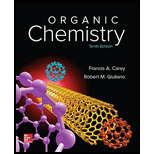
Interpretation:
The number of peaks into which the
Concept introduction:
Splitting of a proton signal is a result of coupling with an atom which has a nuclear spin of
The number of peaks into which an NMR signal is split is equal to
Naturally occurring phosphorus is monoisotopic,
The separation between adjacent peaks is equal to the coupling constant.
The signals of both coupled atoms are split by the same value.
Want to see the full answer?
Check out a sample textbook solution
Chapter 14 Solutions
ORGANIC CHEMISTRY-W/ACCESS >CUSTOM<
- Why is 133C-133C spin-spin splitting not observed in ordinary organic compounds?arrow_forwardWhat is the NMR frequency of a 1H nucleus (a proton) in a magnetic field of 13.5 T? Express your answer in megahertz.arrow_forwardThe benzene radical anion has g = 2.0025. At whatfield should you search for resonance in a spectrometeroperating at (a) 9.302 GHz, (b) 33.67 GHz?arrow_forward
- A proton jumps between two sites with δ = 2.7 and δ = 4.8. At what rate of interconversion will the two signals collapse to a single line in a spectrometer operating at 550 MHz?arrow_forwardWhat is the absorption frequency in a 11.7-T magnetic field of 13C Explain the difference between Larmor frequency and absorption frequency for 13C.arrow_forwardWe calculated that the resonance frequency of an 1H in the presence of an 11.74 tesla magnet was 500MHz, and we later saw that a 13C nucleus resonantes at approximately 125 MHz in this same magnetic field. What is the resonance frequency of a 19F nucleus in the presence of an 11.74 tesla magnet?arrow_forward
 Principles of Instrumental AnalysisChemistryISBN:9781305577213Author:Douglas A. Skoog, F. James Holler, Stanley R. CrouchPublisher:Cengage Learning
Principles of Instrumental AnalysisChemistryISBN:9781305577213Author:Douglas A. Skoog, F. James Holler, Stanley R. CrouchPublisher:Cengage Learning
 Macroscale and Microscale Organic ExperimentsChemistryISBN:9781305577190Author:Kenneth L. Williamson, Katherine M. MastersPublisher:Brooks Cole
Macroscale and Microscale Organic ExperimentsChemistryISBN:9781305577190Author:Kenneth L. Williamson, Katherine M. MastersPublisher:Brooks Cole


